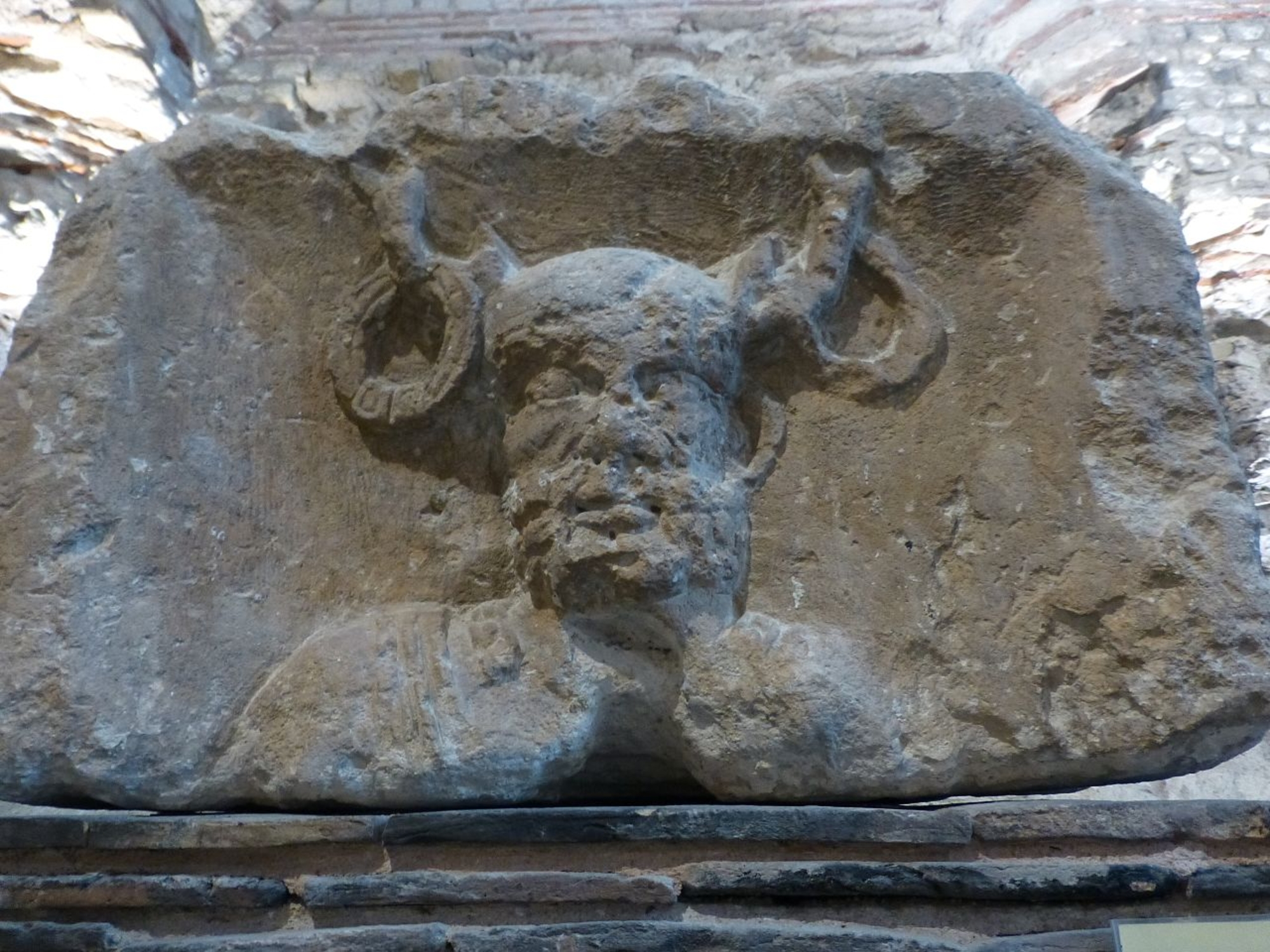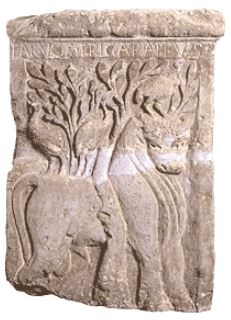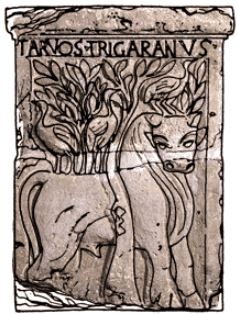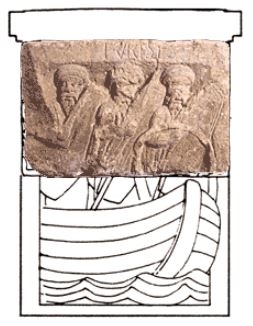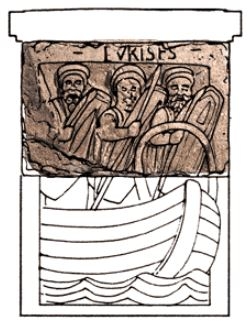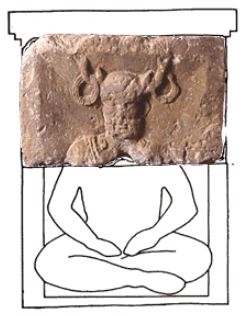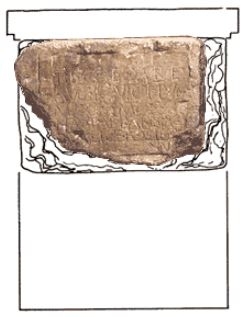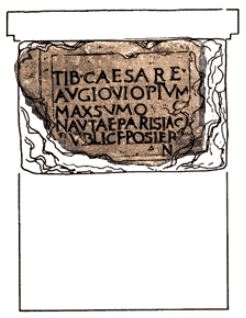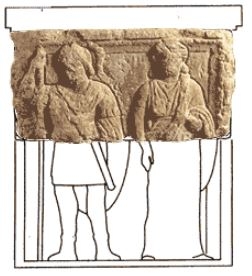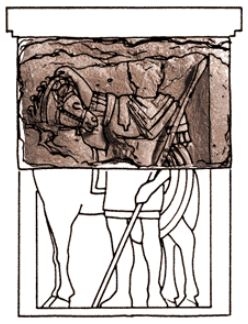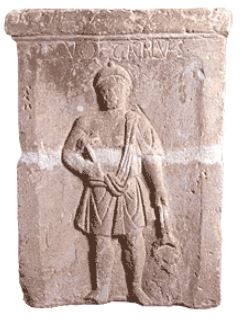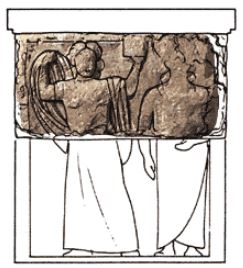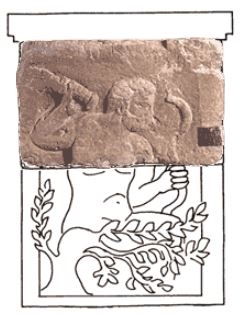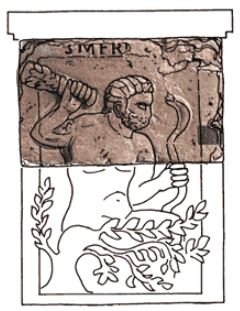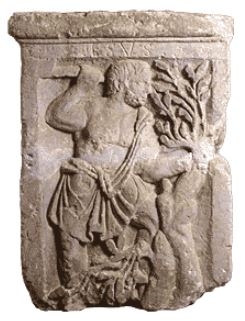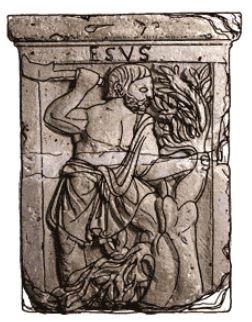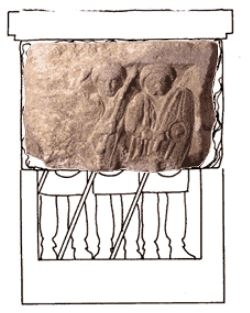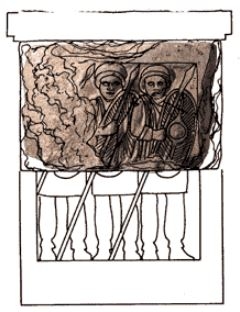- Home
- Aspects of the daily life
- The Boatmen's Pillar
The importance of this pillar is more than a local affair. It is a symbol of the capital of the Parisii, as well as the oldest sculptural group ever found in France and dated by imperial inscription.
It is composed of four blocks that were discovered in 1710, reused in a Late Roman wall found beneath Notre Dame. Their origin remains a mystery-however, all other Early Roman stone blocks discovered on the Île de la Cite came from monuments originally on the city's left bank.
There have been a number of attempts to reassemble the blocks; the bas-reliefs and inscriptions on all four sides make it certain that they were arranged vertically. Not all of the pieces of the pillar have been found, but we may imagine that it stood on a base, and it is possible that the pillar was topped by some sort of statue.
This group is particularly noteworthy because it mixes images from the Greco-Roman pantheon, Celtic divinities and inscriptions highlighted in red ocher. The Boatmen's Pillar is one of the rare testaments to Gallic mythology that has come down to us.
Face 1 & 2
A 3D reconstruction of the Boatmen's Pillar. The darker areas indicate the existing pieces.
3D graphic: © A.-B. Pimpaud based on drawings by J.-P. Adam.
Castor is depicted with his usual attributes.
Photo: A. Chauvet / C2RMF. Drawing by © J.-P. Adam.
Castor is depicted with his usual attributes.
Photo: A. Chauvet / C2RMF. Drawing by © J.-P. Adam.
Behind a tree, we can make out a bull, on whose head and back are perched three cranes. This is the depiction of a Gallic myth or legend, identified by the inscription « TARVOS TRIGARANUS ».
Photo: A. Chauvet / C2RMF. Drawing by © J.-P. Adam.
Behind a tree, we can make out a bull, on whose head and back are perched three cranes. This is the depiction of a Gallic myth or legend, identified by the inscription « TARVOS TRIGARANUS ».
Photo: A. Chauvet / C2RMF. Drawing by © J.-P. Adam.
Three bearded figures, seniores, hold hexagonal shields. Below is possibly depicted the planking of a ship, or a pair of ships-the symbol of ship construction. The upper band bears the inscription « EURISES », perhaps a Gallic word meaning « dedicated ».
Photo: A. Chauvet / C2RMF. Drawing by © J.-P. Adam.
Three bearded figures, seniores, hold hexagonal shields. Below is possibly depicted the planking of a ship, or a pair of ships-the symbol of ship construction. The upper band bears the inscription « EURISES », perhaps a Gallic word meaning « dedicated ».
Photo: A. Chauvet / C2RMF. Drawing by © J.-P. Adam.
This face shows two deities, perhaps Juno on the left holding a scepter or a torch, and Fortuna on the right. In the band at the top there is an incomplete inscription FOR [...].
Photo: A. Chauvet / C2RMF. Drawing by © J.-P. Adam.
This face shows two deities, perhaps Juno on the left holding a scepter or a torch, and Fortuna on the right. In the band at the top there is an incomplete inscription FOR [...].
Photo: A. Chauvet / C2RMF. Drawing by © J.-P. Adam.
This is the representation of the Gallic god Cernunnos. His head is bald and bearded, has animal ears and antlers, from which hang Celtic necklaces.
Photo: A. Chauvet / C2RMF. Drawing by © J.-P. Adam.
This is the representation of the Gallic god Cernunnos. His head is bald and bearded, has animal ears and antlers, from which hang Celtic necklaces.
Photo: A. Chauvet / C2RMF. Drawing by © J.-P. Adam.
Jupiter leans on a scepter and holds a lightning bolt in his right hand, beneath which we can make out the outline of an eagle. The upper band bears an inscription,« IOVIS », which identifies the god.
Photo: A. Chauvet / C2RMF. Drawing by © J.-P. Adam.
Jupiter leans on a scepter and holds a lightning bolt in his right hand, beneath which we can make out the outline of an eagle. The upper band bears an inscription,« IOVIS », which identifies the god.
Photo: A. Chauvet / C2RMF. Drawing by © J.-P. Adam.
This Latin inscription can be translated as follows :
« To Tiberius Caesar Augustus, and to Jupiter, very kind, very great, the boatmen of the territory of the Parisii have erected this monument at their own expense. ».
Photo: A. Chauvet / C2RMF. Drawing by © J.-P. Adam.
This Latin inscription can be translated as follows :
« To Tiberius Caesar Augustus, and to Jupiter, very kind, very great, the boatmen of the territory of the Parisii have erected this monument at their own expense. ».
Photo: A. Chauvet / C2RMF. Drawing by © J.-P. Adam.
Mars is accompanied by a goddess who could be Minerva, Venus, Boudana (a Celtic deity) or Ceres. The upper band bore an inscription that is now lost.
Photo: A. Chauvet / C2RMF. Drawing by © J.-P. Adam.
Mars is accompanied by a goddess who could be Minerva, Venus, Boudana (a Celtic deity) or Ceres. The upper band bore an inscription that is now lost.
Photo: A. Chauvet / C2RMF. Drawing by © J.-P. Adam.
Face 3 & 4
A 3D reconstruction of the Boatmen's Pillar. The darker areas indicate the existing pieces.
3D graphic: A.-B. Pimpaud based on drawings by © J.-P. Adam.
Pollux, the brother of Castor, is depicted with his usual attributes.
Photo © A. Chauvet / C2RMF. Drawing ©J.-P. Adam.
Pollux, the brother of Castor, is depicted with his usual attributes.
Photo © A. Chauvet / C2RMF. Drawing ©J.-P. Adam.
This facade shows Vulcan with his usual attributes. The upper band bears the inscription « VOLCANUS ».
Photo © A. Chauvet / C2RMF. Drawing ©J.-P. Adam.
This facade shows Vulcan with his usual attributes. The upper band bears the inscription « VOLCANUS ».
Photo © A. Chauvet / C2RMF. Drawing ©J.-P. Adam.
At least one of the two figures facing forward is feminine; there is also a head in profile wearing a crown of medallions. The band at the top bears an incomplete inscription « SENANT[...] », which could either be related to « sen », indicating old age, or « virgin priestesses of sailors ».
Photo © A. Chauvet / C2RMF. Drawing ©J.-P. Adam.
At least one of the two figures facing forward is feminine; there is also a head in profile wearing a crown of medallions. The band at the top bears an incomplete inscription « SENANT[...] », which could either be related to « sen », indicating old age, or « virgin priestesses of sailors ».
Photo © A. Chauvet / C2RMF. Drawing ©J.-P. Adam.
This may be Venus looking at herself in a mirror. The other female figure has not been identified.
Photo © A. Chauvet / C2RMF. Drawing ©J.-P. Adam.
This may be Venus looking at herself in a mirror. The other female figure has not been identified.
Photo © A. Chauvet / C2RMF. Drawing ©J.-P. Adam.
The inscription « SMER[...] » allows us to identify the Gallic god Smertrios. He is raising a massue to crush a snake.
Photo © A. Chauvet / C2RMF. Drawing ©J.-P. Adam.
The inscription « SMER[...] » allows us to identify the Gallic god Smertrios. He is raising a massue to crush a snake.
Photo © A. Chauvet / C2RMF. Drawing ©J.-P. Adam.
A Gallic god, identified by the inscription « ESUS », pruning a tree with the help of a billhook.
Photo © A. Chauvet / C2RMF. Drawing ©J.-P. Adam.
A Gallic god, identified by the inscription « ESUS », pruning a tree with the help of a billhook.
Photo © A. Chauvet / C2RMF. Drawing ©J.-P. Adam.
On this face, three ship owners-juniores, judging from their beardless faces-are wearing a helmet or a hat, and are armed with a spear and shield.
Photo © A. Chauvet / C2RMF. Drawing ©J.-P. Adam.
On this face, three ship owners-juniores, judging from their beardless faces-are wearing a helmet or a hat, and are armed with a spear and shield.
Photo © A. Chauvet / C2RMF. Drawing ©J.-P. Adam.
Mercury is accompanied by a goddess who could be his paredra Rosmerta (but without her caduceus), Minerva or Juno
Photo © A. Chauvet / C2RMF. Drawing ©J.-P. Adam.
Mercury is accompanied by a goddess who could be his paredra Rosmerta (but without her caduceus), Minerva or Juno
Photo © A. Chauvet / C2RMF. Drawing ©J.-P. Adam.
